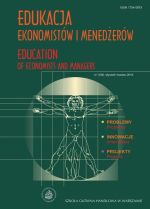Treść głównego artykułu
Abstrakt
Since early 1990s the system of financing higher education institutions in Poland is based on the algorithm which binds the value of subsidy also with the performance. It is basically depended on the number and the structure of the students and scientific staff, but within the past years new factors have been introduced: grants acquisition and internationalization. The goal of the article is to verify to what extent the value of the subsidy depended on the performance of the universities. The test produced the positive outcome for the universities of life sciences and universities of economics, which were outstanding for the statistically significant change of the index.
Słowa kluczowe
Szczegóły artykułu
Autor (Autorzy) artykułu oświadcza, że przesłane opracowanie nie narusza praw autorskich osób trzecich. Wyraża zgodę na poddanie artykułu procedurze recenzji oraz dokonanie zmian redakcyjnych. Przenosi nieodpłatnie na Oficynę Wydawniczą SGH autorskie prawa majątkowe do utworu na polach eksploatacji wymienionych w art. 50 Ustawy z dnia 4 lutego 1994 r. o prawie autorskim i prawach pokrewnych – pod warunkiem, że praca została zaakceptowana do publikacji i opublikowana.
Oficyna Wydawnicza SGH posiada autorskie prawa majątkowe do wszystkich treści czasopisma. Zamieszczenie tekstu artykuły w repozytorium, na stronie domowej autora lub na innej stronie jest dozwolone o ile nie wiąże się z pozyskiwaniem korzyści majątkowych, a tekst wyposażony będzie w informacje źródłowe (w tym również tytuł, rok, numer i adres internetowy czasopisma).
Osoby zainteresowane komercyjnym wykorzystaniem zawartości czasopisma proszone są o kontakt z Redakcją.
![]()
Referencje
-
1. Abramo, G., Cicero, T., D’Angelo, C. (2011). The dangers of performance based research funding in non‑competitive higher education systems. Scientometrics, 87(3), June, 641–654.
2. Bukowska, G., Buczek, J. (2015). Finansowanie edukacji wyższej w Europie. Od modelu egalitarnego do elitarnego. Warszawa: Instytut Badań Edukacyjnych. Downloaded 27.07.2016 from http://forumakad.pl/archiwum/98/7‑8/artykuly/07‑zycie_akad.htm.
3. Granger, C. W. J., (1969). Investigating Causal Relations by Econometric Models and Cross‑spectral Methods. Econometrica, 37(3), 424–438.
4. GUS (2002–2015). Szkoły wyższe i ich finanse, Annuals from 2002 till 2015, Central Statistical Office in Poland, Warszawa.
5. Hillman, N., Tandberg, D., Gross, J. (2014). Performance funding in higher education: do financial incentives impact college completion. Journal of Higher Education, 85(6), November/December, 826–857.
6. Jongbloed, B., Vossenteyn, H. (2001). Keeping up Performances: an international survey of performance‑based funding in higher education.Journal of Higher Education Policy and Management, 23(2), 127–145.
7. Liu, Y. (2011). Performance based funding and budgeting in higher education, NAAAS & Affiliates Conference Monographs, 1516–1539.
8. MNiSW (2015). Rozporządzenie Ministra Nauki i Szkolnictwa Wyższego z dnia 27 marca 2015 r. w sprawie sposobu podziału dotacji z budżetu państwa dla uczelni publicznych i niepublicznych, Journal of Laws (April 2015, Item 463).
9. Orr, D., Jaeger, M., A. Schwarzenberger (2007). Performance‑based funding as an instrument of competition in German higher education. Journal of Higher Education Policy and Management, 29(1), March, 3–23.
10. Rocki, M. (1998). Jak dzielić dotację? Forum Akademickie, 7–8, 6–7.
11. Tochkov, K., Nenovsky, N., Tochkov, K. (2012). University efficiency and public funding for higher education in Bulgaria. Post‑communist Economies, 24(4), December, 517–534.
12. Veiderpass, A., McKelvey, M. (2016). Evaluating the performance of higher education institutions in Europe: a nonparametric efficiency analysis of 944 institutions. Applied Economics, 48(16–18), April, 1504–1514.
13. Williams, R., de Rassenfosse, G. (2016). Pitfalls in aggregating performance measures in higher education. Studies in Higher Education, 41(1), 51–62.
Referencje
2. Bukowska, G., Buczek, J. (2015). Finansowanie edukacji wyższej w Europie. Od modelu egalitarnego do elitarnego. Warszawa: Instytut Badań Edukacyjnych. Downloaded 27.07.2016 from http://forumakad.pl/archiwum/98/7‑8/artykuly/07‑zycie_akad.htm.
3. Granger, C. W. J., (1969). Investigating Causal Relations by Econometric Models and Cross‑spectral Methods. Econometrica, 37(3), 424–438.
4. GUS (2002–2015). Szkoły wyższe i ich finanse, Annuals from 2002 till 2015, Central Statistical Office in Poland, Warszawa.
5. Hillman, N., Tandberg, D., Gross, J. (2014). Performance funding in higher education: do financial incentives impact college completion. Journal of Higher Education, 85(6), November/December, 826–857.
6. Jongbloed, B., Vossenteyn, H. (2001). Keeping up Performances: an international survey of performance‑based funding in higher education.Journal of Higher Education Policy and Management, 23(2), 127–145.
7. Liu, Y. (2011). Performance based funding and budgeting in higher education, NAAAS & Affiliates Conference Monographs, 1516–1539.
8. MNiSW (2015). Rozporządzenie Ministra Nauki i Szkolnictwa Wyższego z dnia 27 marca 2015 r. w sprawie sposobu podziału dotacji z budżetu państwa dla uczelni publicznych i niepublicznych, Journal of Laws (April 2015, Item 463).
9. Orr, D., Jaeger, M., A. Schwarzenberger (2007). Performance‑based funding as an instrument of competition in German higher education. Journal of Higher Education Policy and Management, 29(1), March, 3–23.
10. Rocki, M. (1998). Jak dzielić dotację? Forum Akademickie, 7–8, 6–7.
11. Tochkov, K., Nenovsky, N., Tochkov, K. (2012). University efficiency and public funding for higher education in Bulgaria. Post‑communist Economies, 24(4), December, 517–534.
12. Veiderpass, A., McKelvey, M. (2016). Evaluating the performance of higher education institutions in Europe: a nonparametric efficiency analysis of 944 institutions. Applied Economics, 48(16–18), April, 1504–1514.
13. Williams, R., de Rassenfosse, G. (2016). Pitfalls in aggregating performance measures in higher education. Studies in Higher Education, 41(1), 51–62.
